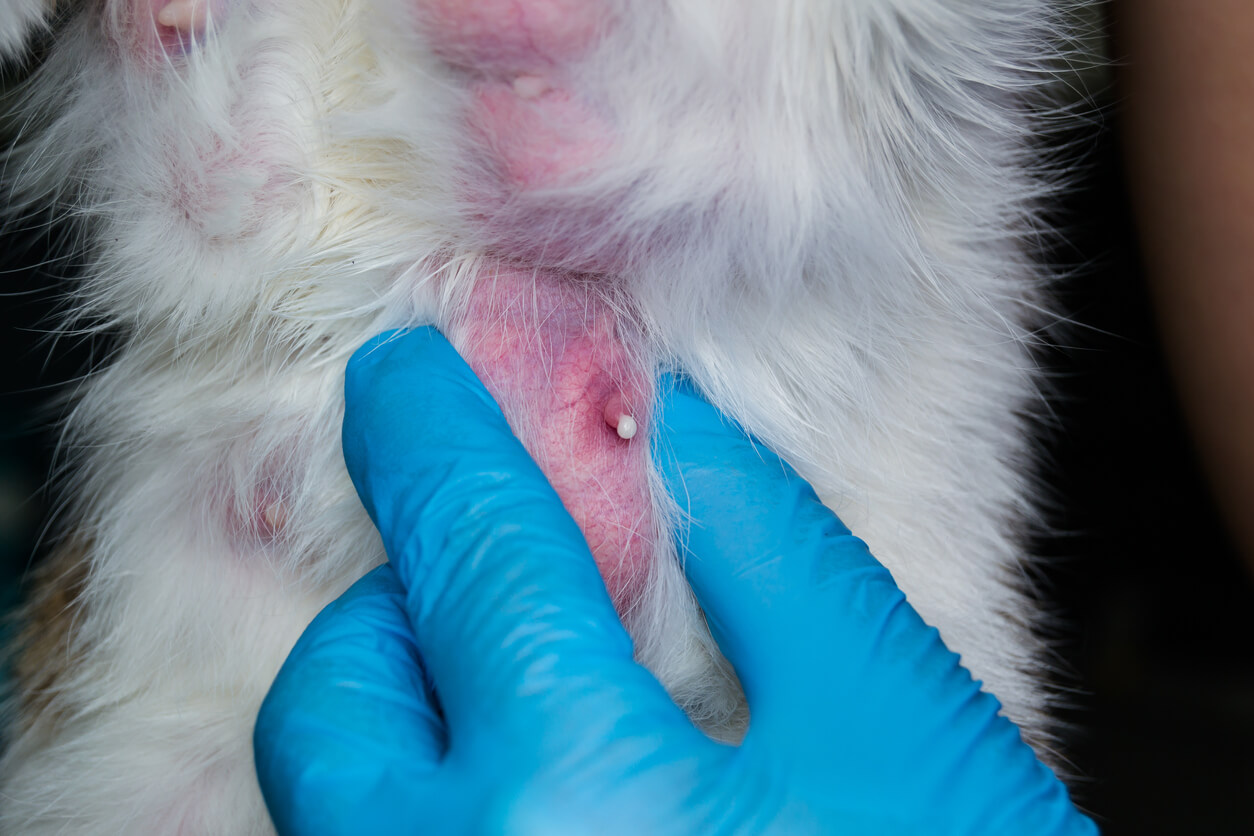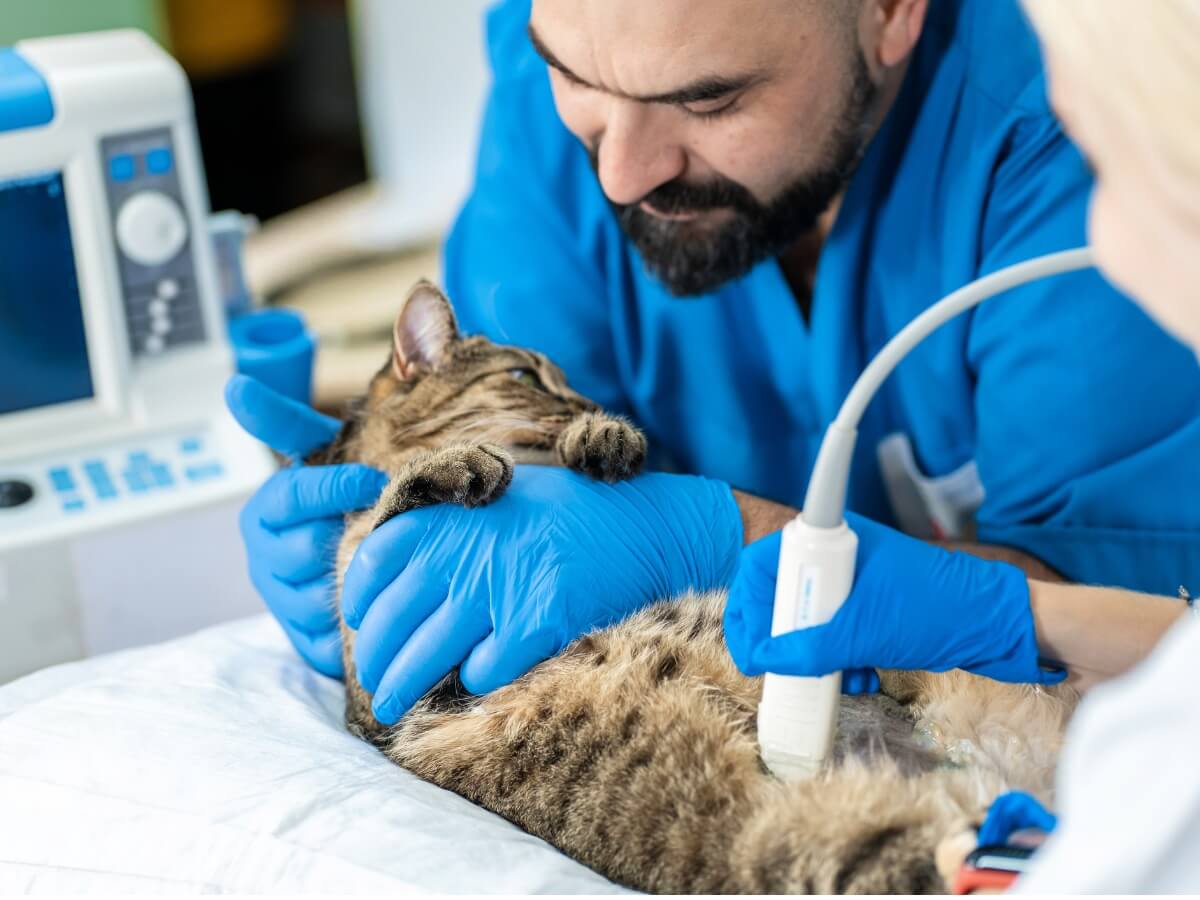Breast Tumors in Cats: Causes, Symptoms and Treatment


Written and verified by the biologist Samuel Sanchez
Talking about tumors isn’t pleasant for anyone, as they’re associated with suffering, chemotherapy, battling, and sometimes death. Not all tumor masses are cancerous, but that’s always the first suspicion, and we need to act as quickly as possible. In the case of breast tumors in cats, it’s no different.
As indicated by the Flint Animal Cancer Center, 1 in 5 cats develops cancer in their lifetime, especially in their senior stage. Unfortunately, in contrast to dogs, the vast majority of mammary tumors in felines are malignant. If you want to know more about this topic, we encourage you to continue reading.
What are breast tumors in cats?
According to the Cancer Dictionary, a tumor is an abnormal mass of tissue that arises when cells multiply more than they should or don’t die when they should. These formations can appear in practically all parts of the body, since the cellular aggregates that make up our body must be replaced and repaired from time to time.
As you can imagine, in the condition that concerns us here, tumors begin to grow and attach themselves to the mammary glands. Female cats have a total of 8 nipples and the tumors appear in the initial stages as very small and firm nodules attached to the mammary gland.
As indicated by the Cornell Feline Health Center, 30 to 40% of cats will develop cancer at some point in their life and 1/3 of the cases are malignant mammary tumors. 95% of tumor masses appear in females, and it’s the third most common malignant neoplasm in this domestic species.
Breast tumors in cats are one of the most common cancers in this species.

Types of breast tumors in cats
Tumors are divided into two categories according to the severity of the condition: malignant and benign. We break down the properties of each of them in the following section:
Benign tumor
Unfortunately, benign masses only represent 10-15% of mammary tumors in cats. These are self-limited, grow to a certain extent, and don’t spread to other parts of the animal’s body. Its prognosis is much better than that of its counterpart.
Malignant tumor
85-90% of mammary tumors in cats are carcinogenic. This means that a cell line has erroneously mutated and is growing rampantly, thus causing the appearance of a neoplastic mass that can spread to other parts of the body. There are several types of cancer that affect the breasts of cats, but adenocarcinoma is the most common.
Adenocarcinomas are cancers of the glandular tissues. They tend to spread to the lungs, pleura, liver, adrenal gland, kidneys, and other parts of the body.
Although making the distinction between malignant and benign tumors is very useful, there are certain concepts to keep in mind. Among them, we highlight the following:
- A benign tumor can turn into a malignant one over time
- The presence of multiple mammary tumors requires individual analysis, as they can be of various types
- Within the same tumor, there may be a mixture of benign and malignant cells
Symptoms of breast tumor in cats
As we said earlier, the most common symptom of this condition is the presence of a small nodule (or several) under the skin in the cat’s abdominal area. It usually occurs near or within one of the nipples, although signs of expansion towards other mammary glands can also be observed.
Sometimes the tumor mass ulcerates, causing an open wound and drainage of pus and blood. Due to this, the affected cat will lick the area excessively and will show obvious signs of pain, especially when getting into certain positions.
In the case of cancer which has already metastasized (spread to other parts of the body), the symptoms become general. The cat will eat less, be listless, exercise less, and possibly have breathing problems.
Possible causes
Talking about causality in the appearance of breast tumors in cats is very complex, as not enough is known about these processes at a clinical level. However, we do know that exposure of the cat to her reproductive hormones dramatically increases the chances of developing breast cancer.
Interestingly, it’s believed that the concentration of estrogen and progesterone in the blood could favor the growth and activation of breast cells, and, therefore, increase the chances of developing a breast tumor. Cats that have been neutered at 6 months of age only have a 9% chance of developing carcinomas, while this value is multiplied by 7 in those that haven’t.
The best prevention method is always to castrate the cat by ovariotomy. The chances of developing breast cancer after the intervention are very low.
Diagnosis of breast tumor in cats
The first part of diagnosing this condition is the physical examination, in which one or more masses will be located in the cat’s abdomen. Before laboratory tests, it’s recommended to perform a series of X-rays and blood tests on the animal. Not all breast tumors in cats are malignant, but it’s necessary to operate on it and evaluate possible metastases as soon as possible.
Once the general health of the cat has been verified, a sample of the tumor mass is usually obtained by aspiration with a fine needle. The sample is observed with different techniques and it’ll be confirmed whether the mass is carcinogenic or not. Unfortunately, the diagnosis is almost always the most feared one.
Treatment
Surgical removal of the tumor should always be the first step, be it benign or malignant. If the cat doesn’t have cancer, it’s most likely that this procedure will be enough and the animal will be completely cured. On the other hand, if the tumors are cancerous, then things get much more complicated.
In addition to tumor removal, a resection of the entire mammary gland and associated lymph nodes is usually necessary for cancer. Chemotherapy is also used in cats that have signs of metastasis or very large tumors whose spread is practically inevitable.

Final notes
A benign breast tumor in cats doesn’t cause any major problems and the animal is cured after surgery. However, cancer cases 66% of felines end up relapsing after a while. The survival rate depends very much on the size of the tumor. If it’s greater than 3 centimeters (1.2 inches), then life expectancy is 6 months, but they may live up to 2 years with tumors that are smaller than 2 centimeters (0.8 inches).
In addition to all the aforementioned, it’s worth pointing out that most mammary tumors appear when the animal is older, generally at 11-12 years of age. For this and many other reasons, estimating the average life expectancy of a cat with breast cancer is very difficult. Ultimately, the prognosis depends on the speed of detection, the approach used, and a little bit of luck.
All cited sources were thoroughly reviewed by our team to ensure their quality, reliability, currency, and validity. The bibliography of this article was considered reliable and of academic or scientific accuracy.
- Common cancer in cats, Flint Animal Center. Recogido a 30 de agosto en https://www.csuanimalcancercenter.org/2019/11/20/common-cancers-in-cats/#:~:text=One%20in%20five%20cats%20will,lives%20after%20a%20cancer%20diagnosis.
- Definición de tumor, Instuto Nacional del Cancer. Recogido a 30 de agosto en https://www.cancer.gov/espanol/publicaciones/diccionarios/diccionario-cancer/def/tumor
- Mammary tumors, Cornell Feline Health Center. Recogido a 30 de agosto en https://www.vet.cornell.edu/departments-centers-and-institutes/cornell-feline-health-center/health-information/feline-health-topics/mammary-tumors
This text is provided for informational purposes only and does not replace consultation with a professional. If in doubt, consult your specialist.